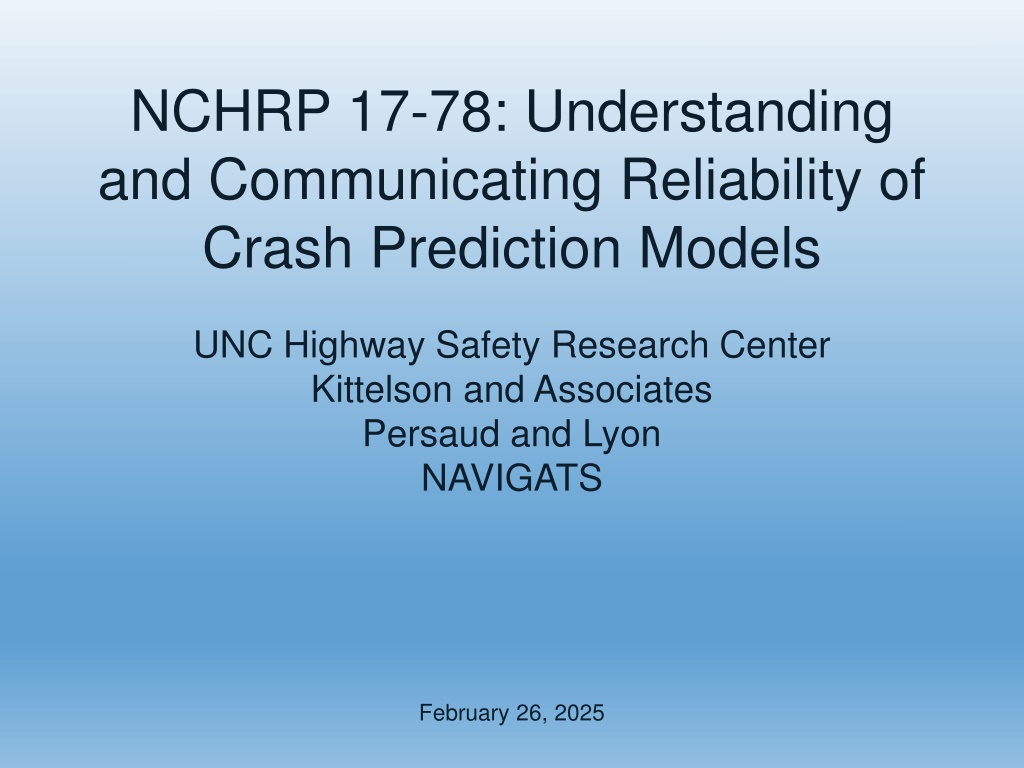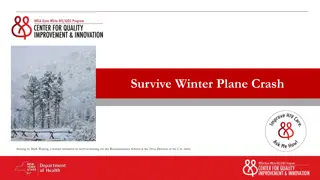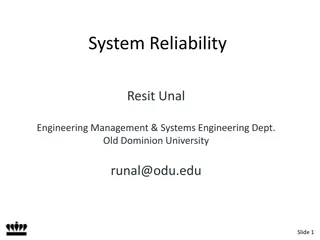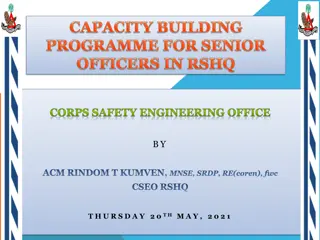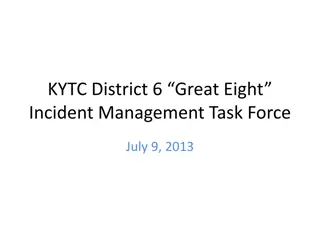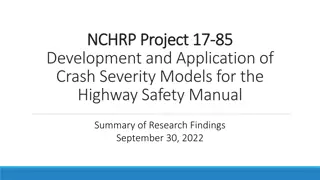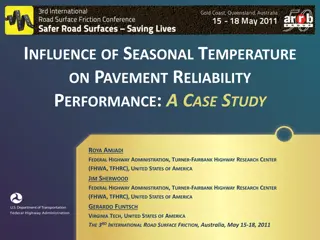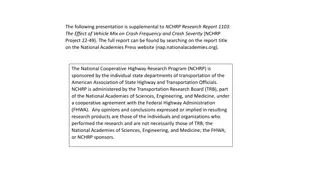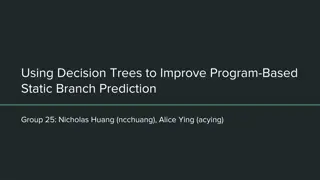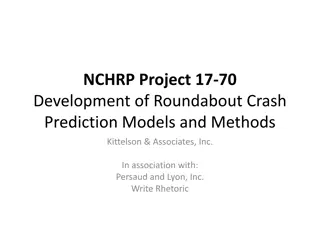Reliability of Crash Prediction Models
Dive into the quantification and interpretation of the reliability of Crash Prediction Models (CPMs) for practitioner use. Explore factors influencing reliability, bias, variance, and repeatability in CPM estimates. Develop guidance for users on model application, data ranges, and intended uses.
Download Presentation

Please find below an Image/Link to download the presentation.
The content on the website is provided AS IS for your information and personal use only. It may not be sold, licensed, or shared on other websites without obtaining consent from the author.If you encounter any issues during the download, it is possible that the publisher has removed the file from their server.
You are allowed to download the files provided on this website for personal or commercial use, subject to the condition that they are used lawfully. All files are the property of their respective owners.
The content on the website is provided AS IS for your information and personal use only. It may not be sold, licensed, or shared on other websites without obtaining consent from the author.
E N D
Presentation Transcript
NCHRP 17-78: Understanding and Communicating Reliability of Crash Prediction Models UNC Highway Safety Research Center Kittelson and Associates Persaud and Lyon NAVIGATS February 26, 2025
Project Team UNC Highway Safety Research Center (HSRC) Raghavan Srinivasan, Daniel Carter, Bo Lan, and Caroline Mozingo Persaud & Lyon (P&L) Bhagwant Persaud and Craig Lyon Kittelson and Associates (KAI) James Bonneson, Erin Ferguson, and Nick Foster NAVIGATS Geni Bahar
Background HSM Part C Predictive Method: Base model, which is a safety performance function (SPF) Crash modification factors (CMFs) to adjust for conditions different from the base conditions Calibration factor to adjust the estimate for local conditions Product of these factors produces a crash prediction model (CPM) HSM has limited information about reliability of predictions from a CPM
Objectives Develop guidance for the quantification of the reliability of CPMs for practitioner use; Develop guidance for user interpretation of model reliability; and Develop guidance for the application of CPMs accounting for, but not limited to, assumptions, data ranges, and intended and unintended uses.
Reliability of CPMs Bias Difference between the CPM estimate and the true value Variance Extent of uncertainty in the CPF estimate Repeatability The extent to which multiple analysts using the same CPM with the same training, data sources, and site of interest obtain the same results
Factors Influencing Reliability Categories: Model Related & Application Related Factors Model Related Factors Application of CPMs with and without calibration Add EB method Add CMFs from other sources (consistent with base conditions) Updating CPMs for changes over time Use jurisdiction-specific base condition SPFs Use crash modification functions (CMFunctions) instead of CMFs
Factors Influencing Reliability: contd. Application Related Factors Error and uncertainty in the input values Use of CMFs that are inconsistent with the base conditions of the CPM Relative impact of a CPM variable Omitted variables in CPM Missing application data Applications of the CPMs for rare crash types Application exceeds the range of an input variable Application site has characteristics that are not represented by CPM
Survey of Practitioners to Assess Importance of Different Factors Survey was sent to: AASHTO Safety Management subcommittee AASHTO HSM2 Steering Committee FHWA HSM Pooled Fund Group Respondents were provided with 7 issues and asked to indicate: Very concerning Somewhat concerning Neutral Not very concerning Not a concern
Survey of Practitioners, 7 issues Using CPMs that were developed in another jurisdiction but calibrated for your local jurisdiction Using CMFs not included in the original CPM but are consistent with the base conditions of the CPMs Using CMFs not included in the original CPM but are inconsistent with the base conditions of the CPMs Using a CPM that does not represent the characteristics of your project Using input values that are uncertain Using a CPM for a project whose characteristics lie outside the range of the values of the CPM development Using a CPM to estimate rare crash types
Focus of the Research Project Procedures for Quantifying the Reliability of Crash Prediction Model Estimates with a Focus on: Mismatch between CMFs and SPF Base Conditions Error in Estimated Input Values How the Number of Variables in CPM Affects Reliability
Focus of the Research Project, contd. Reliability Associated with Using a CPM to Estimate Frequency of Rare Crash Types and Severities Predicting Outside the Range of Independent Variables Predictions Using CPMs Estimated for Other Facility Types February 26, 2025
Objective of This Presentation Provide an overview of each topic/scenario along with the steps involved in the guidance Examples and case studies are provided in the following document: NCHRP Research Report 983: Reliability of Crash Prediction Models: A Guide for Quantifying and Improving the Reliability of Model Results February 26, 2025
Scenario 1: Reliability of CPM Estimates - Mismatch between CMFs and SPF Base Conditions CMFs and SPF Base Conditions not Matched Application Cases A. CMFs in predictive model match to base condition variables in SPF B. One or more CMFs used with the model do not match with the base condition variables in SPF C. One or more CMFs not used, yet the associated base condition exists in the SPF February 26, 2025
Reliability of CPM Estimates - Mismatch between CMFs and SPF Base Conditions Objectives Develop technique to quantify the influence of Cases B and C on reliability of the prediction Demonstrate its use to interpret model reliability February 26, 2025
Base Condition Mismatch (Procedures) Case A: CMF from Part D used with SPF (CMF is consistent with SPF base conditions) Step 1. Assemble the data needed to apply the procedure Step 2. Compute estimation coefficient Step 3. Compute bias adjustment factor Step 4. Compute the predicted crash frequency for site of interest February 26, 2025
Base Condition Mismatch (Procedures),Case A, contd. Case A: CMF from Part D used with SPF (CMF is consistent with SPF base conditions) Step 5. Compute the unbiased predicted crash frequency for site of interest Step 6. Compute the increased root mean square and coefficient of variation Step 7. Compute the amount of bias February 26, 2025
Base Condition Mismatch (Procedures) Case B: CMFs Do Not Have a Corresponding Base Condition in the SPF Step 1. Assemble the data needed to apply the procedure Step 2. Compute estimation coefficient Step 3. Compute bias adjustment factor Step 4. Compute the predicted crash frequency for site of interest February 26, 2025
Base Condition Mismatch (Procedures), Case B, contd. Case B: CMFs Do Not Have a Corresponding Base Condition in the SPF Step 5. Compute the unbiased predicted crash frequency for site of interest Step 6. Compute the unbiased overdispersion parameter for the CPM with the external CMF Step 7. Compute the increased root mean square and coefficient of variation Step 8. Compute the amount of bias February 26, 2025
Base Condition Mismatch (Procedures) Case C: CMF Not Used in CPM but Base Condition Accommodated in the SPF Step 1. Assemble the data needed to apply the procedure Step 2. Compute estimation coefficient Step 3. Compute bias adjustment factor Step 4. Compute the predicted crash frequency for site of interest February 26, 2025
Base Condition Mismatch (Procedures), Case C, contd. Case C: CMF Not Used in CPM but Base Condition Accommodated in the SPF Step 5. Compute the unbiased predicted crash frequency for site of interest Step 6. Compute the unbiased overdispersion parameter for the CPM with the omitted CMF Step 7. Compute the increased root mean square and coefficient of variation Step 8. Compute the amount of bias February 26, 2025
Scenario 2: Error in Estimated Input Values Significance of uncertain or erroneous input values depends on context of use: More significant for estimating effect of a contemplated countermeasure or design change Network screening applications may be less impacted Impact of uncertain or erroneous input values on reliability largely dependent on: Degree to which the value is uncertain or erroneous How impactful the variable under question is to the CPM prediction February 26, 2025
Error in Estimated Input Values (contd.) Methods to Assess Potential Reliability Guidance developed is a heuristic procedure that practitioners can use to assess how uncertainty or error in their data may affect reliability Following types of analysis Applying a CPM to predict crash frequency Applying a CPM along with crash data for network screening February 26, 2025
Error in Estimated Input Values (Procedural Steps) Sensitivity Analysis of Predicted Crash Values Step 1. Assemble data Step 2. Calibrate the CPM Step 3. For each variable in the CPM where measurement error is of concern, assign a random number reflecting the degree to which measurement error is suspected for that variable February 26, 2025
Error in Estimated Input Values (Procedural Steps) Sensitivity Analysis of Predicted Crash Values (contd.) Step 4. For each variable in the CPM where measurement error is of concern, multiply the recorded value by the random number generated for that variable in Step 3 Step 5. Apply the CPM twice, once using the original estimated variable values and a second time using the new variable values generated in Step 4 February 26, 2025
Error in Estimated Input Values (Procedural Steps) Sensitivity Analysis of Predicted Crash Values (contd.) Step 6a. Use the values in Step 5 and estimate a series of GOF statistics Step 7a. Divide the root mean square difference and the extreme value estimates from Step 6a by the average value of the crash predictions with known values and multiply by 100 Step 8a. Using the GOF statistics calculated in Step 7a assess the impact of measurement errors on the CPM February 26, 2025
Error in Estimated Input Values (Procedural Steps) Sensitivity Analysis for Network Screening Steps 1 through 5 are the same as for the previous situation (i.e., Sensitivity Analysis of Predicted Crash Values) Step 6b. For each CPM applied, compute either the EB or EB Excess estimate for each site by combining the CPM predicted crash estimate with the observed crash data February 26, 2025
Error in Estimated Input Values (Procedural Steps) Sensitivity Analysis for Network Screening (contd.) Step 7b. For each CPM applied, rank all locations separately by the network screening measure used (EB Expected or EB Excess) Step 8b. For each ranked list determine the Spearman s correlation coefficient, comparing the rankings using the CPMs with measurement error to the ranking using the CPM with the original estimated values February 26, 2025
Error in Estimated Input Values (Procedural Steps) Sensitivity Analysis for Network Screening, contd. Step 9b: For each ranked list, for the top 30, 50, and 100 sites ranked using the base CPM, the percentage of sites not included in the ranked lists using the CPMs with measurement error is tabulated Step 10b: Using the goodness-of-fit measures calculated in Steps 8b and 9b assess the impact of measurement errors on the CPM February 26, 2025
Scenario 3: Effect of Number of Variables in CPM on Reliability Relative Impact of the Variable, e.g., Left turn volumes are influential predictors of left turn crashes Shoulder width may have little influence on total crashes for rural multilane roads Omitted Variables in the CPM, e.g., Estimating crashes on segments with curves with CPM developed without variable for curvature Missing Application Data, e.g., Applying CPM in preliminary design before design elements are finalized February 26, 2025
Effect of Number of Variables in CPM on Reliability Methods to Assess Potential Reliability The guidance developed is a heuristic procedure that practitioners can use to assess how the use or absence of additional variables in a CPM affects reliability Answer two questions: Which of multiple CPMs to apply, particularly when the number of variables varies between SPFs? What are the impacts on reliability of using a CPM when not all the variables in the CPM are known? February 26, 2025
Effect of Number of Variables in CPM on Reliability Procedural Steps Step 1. Assemble all data required for applying the CPM Step 2. Decide how many alternate CPMs are to be compared and which variables will be included in each Step 3. For each CPM being considered, estimate the Modified R2, MAD, dispersion parameter, and the percent of observations outside of two standard deviation limits for the CURE plot for the fitted values For each of these measures, divide the values by the value for the full CPM with all variables February 26, 2025
Effect of Number of Variables in CPM on Reliability Procedural Steps (contd.) Step 4. The analyst should decide how many years of observed crash data will be used in their Network Screening program and whether sites are to be screened by the EB Expected or the EB Excess methods Step 5. For each ranked list determine the Spearman s correlation coefficient, comparing the rankings using the CPM with all variables used to the other CPMs in turn. February 26, 2025
Effect of Number of Variables in CPM on Reliability Procedural Steps (contd.) Step 6. For each ranked list, for the top 30, 50, and 100 sites ranked using the full CPM with all variables, the percentage of sites not included in the ranked lists using the alternate CPMs is tabulated. Step 7. Using the goodness-of-fit measures calculated in Steps 3, 5, and 6, evaluate the alternate CPMs. February 26, 2025
Scenario 4: Reliability Associated with Using CPM for Rare Crash Types and Severities Three cases Case A: Models did not converge or were illogical (e.g., AADT exponents were negative or statistically insignificant at the 10% level). Case B. There is low confidence in a CPM because it did not validate well or had poor GOF statistics. Case C: For numerous crash types and severities, estimation of CPMs was not considered either: because they are not of primary interest generally (e.g., night crashes), or because there are typically too few crashes to attempt SPF development (e.g., bicycle, pedestrian, and fatal crashes). February 26, 2025
Reliability Associated with Using CPM for Rare Crash Types and Severities For such cases, a two-stage fixed proportions approach is applied: A crash type/severity proportion developed from the jurisdiction s data is applied to parent CPM prediction, e.g., a KABC parent CPM, if reliable, would be considered for both KA and KAB crashes, and so on. February 26, 2025
Reliability Associated with Using CPM for Rare Crash Types and Severities If Case A or Case C pertains: a crash type/severity proportion developed from the jurisdiction s data is applied to a prediction from the recommended and calibrated parent SPF (assess using GOF statistics) February 26, 2025
Reliability Associated with Using CPM for Rare Crash Types and Severities If Case B pertains: Approach 1: A Case B uncalibrated SPF that did not validate well or has poor GOF statistics. Such an SPF may not be presented in the HSM but may be retrieved from another source if and when available Approach 2: A modified SPF in which a crash type/severity proportion developed from the jurisdiction s data is applied to a prediction from the HSM recommended and uncalibrated parent SPF February 26, 2025
Reliability Associated with Using CPM for Rare Crash Types and Severities Illustration Where Case A or C pertains SPF predictions for same direction (SD), killed and seriously injured (KA) crashes on 4-lane divided (4D) segments NCHRP Project 17-62 could not estimate base for these crashes because there were none in the database (California) Database for another jurisdiction (Illinois) used for model validation contained 8 such crashes. Question: what SPFs can be used for estimating KA-SD crashes for base conditions in Illinois? February 26, 2025
Reliability Associated with Using CPM for Rare Crash Types and Severities Illustration Where Case B Pertains Several base condition SPFs developed in NCHRP Project 17-62 did not validate well or had poor GOF statistics. The illustration here is for one of those: Same direction (SD), KAB crashes at 4 leg stop controlled (4ST) intersections on multilane roads. Data used in NCHRP Project 17-62 was based on 12 crashes in Minnesota NCHRP Project 17-62 validation data for Ohio are used. Dataset contained 12 KAB-SD crashes February 26, 2025
Scenario 5: Predicting Outside the Range of the Independent Variable HSM states that the application of CPMs to sites with AADTs substantially outside this range may not provide reliable results Data used for estimation versus data used for application Range of variables (especially, AADT) may be different Distribution of variables may be different even if the range is similar February 26, 2025
Predicting Outside the Range of the Independent Variable Maximum AADT values for selected CPMs Roadway Type Source of CPM Maximum AADT (veh/day) 30,025 17,800 21,622 42,638 33,200 21,667 31,188 89,300 66,504 SafetyAnalyst 1st edition of the HSM NCHRP Project 17-62* SafetyAnalyst 1st edition of the HSM NCHRP Project 17-62* SafetyAnalyst 1st edition of the HSM NCHRP Project 17-62* Rural Two-Lane Road Segments Rural Multilane Undivided Segments Rural Multilane Divided Segments Note: * Proposed for 2nd edition of the HSM February 26, 2025
Predicting Outside the Range of the Independent Variable Implicit Assumption functional form of SPFs is applicable/valid outside the range of estimation data bias in prediction may depend on relationship between crashes and site characteristics February 26, 2025
Predicting Outside the Range of the Independent Variable Objective Reliability of using the CPMs to predict the number of crashes at sites whose site characteristics (especially, AADT) are outside the range of the data used to estimate the CPMs February 26, 2025
Predicting Outside the Range of the Independent Variable Different options Option 1: Perform calibration Option 2: Adjust parameter/coefficient for AADT and perform calibration Option 3: Estimate calibration function or SPF by modifying the coefficient for AADT and perform calibration Option 4: Estimate calibration function or SPF and perform calibration Option 5: Estimate calibration function or SPF with different parameters for AADT and the other factors, and perform calibration February 26, 2025
Predicting Outside the Range of the Independent Variable Illustration of the 5 options using HSIS data (2005 to 2014) from California freeways Exclude ramp influence areas for this illustration Exclude segments shorter than 0.01 miles Categorize data by number of lanes, terrain, area type (rural or urban) For the different freeway categories, SPFs were estimated using data from segments with lower AADT values, and they were tested using data from segments with higher AADT values February 26, 2025
Scenario 6: Reliability Associated with Predictions Using CPMs Estimated for Other Facility Types 2nd edition of the HSM will provide CPMs for many facility types There may be facility types for which specific CPMs will not be available Reliability may depend on Functional form of CPM Range of site characteristics February 26, 2025
Reliability Associated with Predictions Using CPMs Estimated for Other Facility Types Ohio North Carolina 4 to 5 lanes 4 to 5 lanes 6 or more lanes 6 or more lanes Urban Rural Urban Rural Estimate (S.E.) Estimate (S.E.) Estimate (S.E.) Estimate (S.E.) Estimate (S.E.) Estimate (S.E.) Variables/Statistics 0.8510 (0.0749) 1.3687 (0.0549) 0.9561 (0.0898) 0.9084 (0.1068) -0.8581 (0.2615) 1.6454 (0.0910) 1.2379 (0.1990) 1.4408 (0.0829) 0.4860 (0.0504) 0.7397 (0.1335) 0.2164 (0.0479) 0.7854 (0.0630) Intercept ln(Day Vol/10000) 0.2610 (0.0086) Day Vol/10000 Within Influence of Interchange/Ramp? (1 for yes, 0 for no) Urban? (1 for yes, 0 for no) 6 or 7 lanes? (1 for yes, 0 for 8+ lanes) Right Shoulder Width (ft) Left Shoulder Width (ft) 0.8902 (0.0814) 0.7628 (0.3997) 0.9702 (0.0684) 0.8235 (0.1828) 0.1814 (0.0512) 0.5209 (0.0873) 0.7014 (0.1038) 0.4881 (0.0455) 0.1750 (0.0513) -0.0652 (0.0119) -0.0310 (0.0031) February 26, 2025
Reliability Associated with Predictions Using CPMs Estimated for Other Facility Types Objective Provide guidance on the reliability of using the CPMs to predict the number of crashes at a different facility type Illustration of the Problem using HSIS data from California: Estimation Group (facility types used for estimating CPMs) Application Group (facility types used for applying the CPMs) February 26, 2025
Reliability Associated with Predictions Using CPMs Estimated for Other Facility Types Group Facility Types used for Estimating CPMs (estimation group) Facility Types Used for Applying the Estimated CPMs (application group) Facility type Crash Types Facility type Segments Segments Group 1 Rural 4 lane, Flat terrain Urban 6 lane, Flat terrain Rural 4 lane, Flat terrain Urban 6 lane, Flat terrain Rural 4 lane, Rolling terrain Urban 6 lane, Rolling terrain Rural 4 lane, Rolling terrain Urban 6 lane, Rolling terrain February 26, 2025 1075 Rural 6 lane, Flat terrain 102 SV, MV, Total 437 Group 2 1075 Urban 4 lane, Flat terrain 428 SV, MV, Total 437 Group 3 421 Rural 6 lane, Rolling terrain 58 SV, MV, Total 253 Group 4 421 Urban 4lane, Rolling terrain 263 SV, MV, Total 253
NCHRP Project 17-78 Products NCHRP Web-Only Document 303 NCHRP Research Report 983: Reliability of Crash Prediction Models: A Guide for Quantifying and Improving the Reliability of Model Results Communications Plan One-page flyer February 26, 2025
